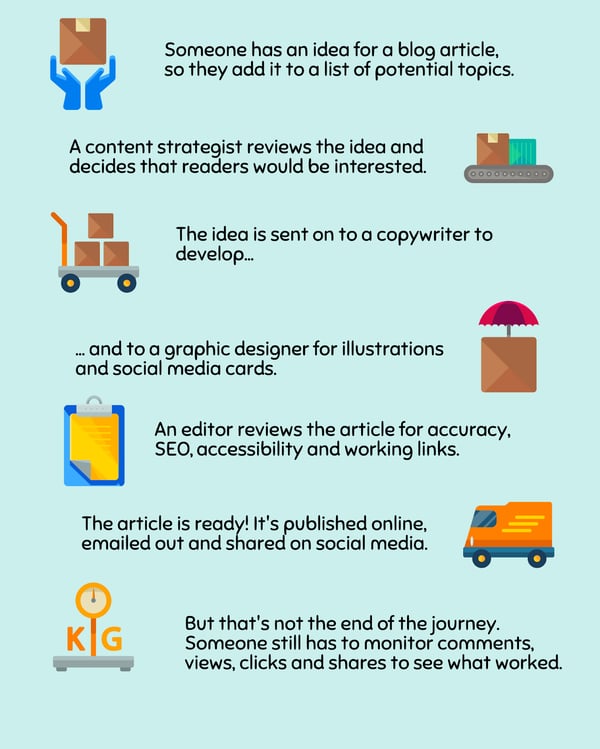October 26, 2020
 by Corinna Keefe / October 26, 2020
by Corinna Keefe / October 26, 2020

You've heard about death by committee: when a piece of content is the victim of too many ideas from too many people.
But what about death by inefficiency, when your content is too slow off the mark, or gets stuck in the production phase? If you're struggling to create great content, then you need a workflow.
Here's how to create a content workflow that coordinates your team, encourages creativity, and delivers results. We'll also take a look at which tools to include in your content marketing stack.
A content workflow is a plan for how content gets produced in your team. It sets out the stages of each project and assigns a specific person to take care of each stage.
Here's a really simple content workflow example for writing a blog:

With a content workflow, you make this process official. You have a documented map of the process. You assign specific tasks with specific deadlines to specific people. That means everybody understands what goes into a piece of content, and who is responsible for it at every point.
So why bother with all this? Here's why:
Sounds good so far, right? Creating a faster content workflow could save you a lot of time and trouble. But first, you'll need to invest some effort into getting set up. The best place to start is with a quick audit of how you create content at the moment.
Ask yourself and your team:
Once you've figured out your content baseline, you should also consider your goals. Ask yourself:
It's worth getting input from everyone involved in creating content for your brand, because they may well spot opportunities or time-savers that you would miss on your own. The answers to all these questions should provide you with new aims for your content workflow.
We strongly recommend using SMART goals here, because (just like the workflow itself) concrete targets are more effective than vague promises. If someone says, "we'd love to produce more content,” you should hear alarm bells. But if they say, "we'd like to start publishing two videos a week by December," it’s a realistic goal that is also attainable.
Your content workflow should be similarly detailed. Here's the information to look for in a content workflow:
Paradoxically, an ultra-specific workflow like this actually gives you more flexibility. Why? Because you know exactly what's happening, all the time. This makes it much easier to add in urgent projects, manage workloads, and introduce new ideas.
You can write your content workflow up in a document, draw it as a flowchart, or create a project template in your task management software of choice. So long as you have it recorded somewhere, that's fine.
Everybody involved in content creation should know where to find a map of the basic workflow, and they should have a clear idea of where they fit into each individual project. Every time someone new joins the team, they should get a detailed walk-through so that they can find their place in the workflow, too.
Every business is different. Depending on which content formats you work with, how big your team is, how experienced they are, and more, your needs will be very different. Still, there are some software types universally usable for perfecting your content workflow.
It's worth bearing in mind that in most of these categories, there are a range of solutions aimed at different-sized businesses. Many tools also offer sliding-scale pricing plans for freelancers, small businesses, charities, and large corporations. Don't dismiss any of this software out of hand – it may be more affordable and more necessary than you think.
Your content workflow is a template for how projects happen. Your task management software is where individual projects carry out that template. So your task management software should accommodate all the essential features of your workflow.
This includes:
Fortunately, this describes most task management software out there! We won't get into all the different types of task or project management software here, but rest assured you have plenty of options.
Earlier in this article, we recommended assigning specific tools for specific tasks in the same way that you set a deadline or a team member for each task. There are several reasons for this. When you're working in a busy team, even if you want creative and varied results, you need predictable processes.
Team members need predictable processes. They need to know what file types to expect, where they can find documents and design assets, and exactly what they can create within a given timeframe. Not to mention, of course, that it's infinitely cheaper to use a few good programs across the team, than to let every individual pick their own software.
Finally, when you keep using the same image editing programs, your content will develop a recognizable look. That doesn't mean it's boring – it just means that your customers can rely on you. A recognizable look is part of building brand trust. If you can create branded templates to reuse in different pieces of content, you'll save time as well.
The specific software you choose will also depend on your level of expertise. If you have an in-house graphic designer, great! They'll probably have some ideas of what software they want to use.
But if you're multitasking or new to design, then it's best to stick with a simple, drag-and-drop design tool. There are a lot of generalized and specialist tools out there; for example, many people swear by Canva for social media graphics, while others like Easelly for basic infographics.
Yes, this category matters. Even though video is now the biggest content format on the internet, it’s incredible how few brands have content workflows set up for creating video. The result? Their videos are out of date, unprofessional, or simply inconsistent. This is another form of content where standardizing your stack really makes a difference.
At a minimum, you should know:
If that sounds intimidating, don't panic. Just like image editing software, there is a whole world of options out there – from programs worthy of an Oscar-winning movie, to drag-and-drop storyboards for dummies.
If you're new to creating branded videos, this is a pretty good place to start. Even if you just decide to use the in-app tools on social networks, that fact should be documented in your content workflow.
Subtitling software is something which many brands neglect, but it is key for accessibility. Many social networks offer automated captions these days, but the quality can be unreliable. Adobe Spark, Kapwing and Clideo are all popular options for adding video captions on desktop. If you prefer to edit videos on mobile, try AutoCap (Android) or Caption This (iOS).
Next on the list: a content hack. When you're creating a content workflow, you should include repurposing and resharing content by default. What does that mean? It means if you create an article, you should use the article's content to create an infographic, a text-only video and a set of quotes to share on social media, and keep sharing them at regular intervals.
It means if you make a video, you should re-cut it into shorter clips and gifs to share on social media, and keep sharing them at regular intervals. You get the idea. You should also be reviewing old content regularly to check that it's accurate and up to date, and all the links still work.
Most content repurposing can be achieved with your existing content stack, but there are some specialist apps for the job as well. For instance, Remix can transform quotes or articles into cards to share on social media. The design is really customizable and it's very easy to use, so it works well if you want to repurpose content but you don't have a lot of time.
Your task management software is also a key part of repurposing, reviewing, and resharing content. Set regular reminders for yourself so that no piece of content is wasted.
This is a big one. People like interactive content. They spend more time on it. They remember it better. They enjoy it more. So why are so few brands creating interactive content? Well, because it sounds scary and complicated. But it's really not.
Interactive content includes:
Here's the thing: all of those examples are pretty easy to set up. And as well as catering tp your audience, interactive content is a powerful way to do market research, generate leads, and collect data from your target market.
Stock footage should be an integral part of content creation. Why? Because it's a lot cheaper and faster than creating your own footage library to cover every possible project. Choosing stock footage, photos or audio doesn't mean compromising on quality, either.
If you want to make something your own, you can edit the stock to reflect your brand image. Here are some really great tips for using stock on social media without anyone noticing. There are a lot of stock libraries these days, and it's worth shopping around to find the combination of price point, library size and specialism that works for you.
Writing doesn't need any special tools, right? Well, that's not quite true. Remember, creating a content workflow isn't just about getting the job done. It's about increasing efficiency, productivity and quality as well.
Here are a few points to consider:
We also strongly recommend creating a style guide (including rules for social media) and at least one or two basic article templates. A clear structure will help your writers to plan and develop blogs faster – and it's also helpful for readers to encounter content with uniformity in style, tone, and mechanics across the board.
We've tried to convince you of one simple thing: workflow + tools = content.
If you have a clear workflow and the right set of tools, you'll produce great content. If you have vague procedures and the wrong tools, then your content will be less than great.
Your content workflow will always be a work in progress. Priorities change, people move around, and software updates. But you'll know if your content workflow is right for right now if it's producing fresh ideas and helping your team collaborate effectively.
Corinna Keefe is a freelance writer specializing in digital marketing, tech, and social media. She works with brands and agencies all over the world, including Easypromos and Invideo.
Publishing on Medium is easy. Getting real results on Medium? That’s harder.
 by Devin Pickell
by Devin Pickell
The evolution of content types is undeniable. Technologies grow, online behavior changes, and...
 by Lesley Vos
by Lesley Vos
Ever feel like your best content isn’t getting the attention it deserves? You spend hours...
 by Sumeet Anand
by Sumeet Anand
Publishing on Medium is easy. Getting real results on Medium? That’s harder.
 by Devin Pickell
by Devin Pickell
The evolution of content types is undeniable. Technologies grow, online behavior changes, and...
 by Lesley Vos
by Lesley Vos


